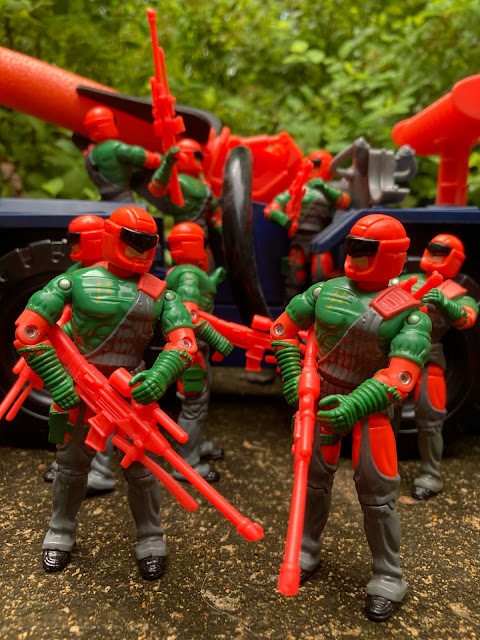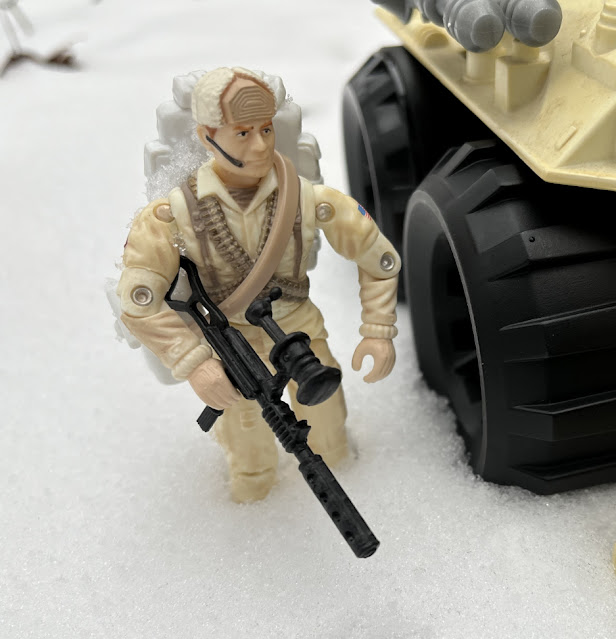I have written many times of my experiences relating to 1993 and 1994 Joes at retail. My late arrival to the hunt coupled with the dawn of adult collectors left me interesting finds at retail. While Joe characters were relatively easy to find, Cobra characters were a rarer find. The rarest find of all, though, was an army builder. In the standard carded series of Joes. I only found the 1993 Crimson Guard Commander and 1994 Viper at retail. (I didn't look for Armor Tech figures. And, you could get various Ninja Force Night Creepers, too.) The remainder of the Cobra army builders were long gone by the time I realized that I needed to buy every Joe at retail that I could find.
The 1992 basic carded line of Joes was only 12 figures. That's incredibly small. But, a lot of the volume was made up for by the 19 figures released in the DEF, Eco Warriors, Ninja Force and Talking Battle Commanders series of figures. Of those 12 standard carded figures, though, 8 of them were remakes of classic characters. General Flagg was the first figure using a popular name from the comics. So, there were just three new character released that year. This rehash was, likely, a response to various market forces as well as a way to keep familiar character names on shelves as the line sputtered a bit towards its ultimate demise. Among the re-imagined characters is the classic Cobra Eel. This character, who debuted in 1985, was the de facto Cobra Frogman and remained popular in the comics. It was also one of the best figures Hasbro ever created. So, any new design had a high bar to clear.
The 1992 mold, though, didn't quite deliver. Bright colors aside, the general design simply wasn't up to par with the 1985. The figure had a lot of potential. But, many of the design points didn't translate into the actual toy. In 1993, the Eel was among 9 of the 12 1992 figures who got an repaint in the initial Battle Corps line. (Big Bear, the 10th 1992 to repainted, was only available as a mail away. Destro and Duke didn't get the repaint treatment (likely because they both had new figure molds for 1993) but would both make up for it in the repaint era (1997-2006) as each mold was used multiple times.) The 1993 Eel is neither better nor worse than the 1992. In fact, they are incredibly similar in appearance with the main difference being a purple body suit instead of a blue from 1992. Both figures, though, suffer from differences between design and production that make a big difference.
In looking at the Eel card art, you can see that the figure was originally intended to be wearing a yellow vest with exposed wet suit appearing under it on the figure's stomach. The production figure is a wall of yellow from the neck to below the belt. Had the stomach been painted to match the wetsuit colors, the Eel would have a visual break on his torso that would have given him more depth. The omission of this paint application makes the figure seem two tone and more fits with cheaper brands than the paint depth that was the hallmark of Hasbro's G.I. Joe line. The artwork also features bare hands. In this case, I'm glad the designers went with gloved hands. I was never a fan of characters who are completely covered save their hands. It's odd that you'd go to the lengths to protect your eyes and face, but not your hands. So, in this case, the figure is better for the change.
The final two details are different. In looking at the figure's head in the card art, you see that he was planned to have black fangs descending from the figure's visor. This would have been a great way to bring some additional color to the figure and break up the sea of yellow. These were dropped, though, and the figure seems a bit unfinished without them. The final aesthetic are the protruding fins on the figure's arms and legs. These rigid plastic details were meant to both be pliable wet suit fins, but also "hull slashing" weapons that were capable of ripping steel. On the figure, the hard plastic works for the latter purpose. But, it also gives the figure a bit of bulk that can be limiting when using him in Cobra aquatic vehicles.
I use 1992 and 1993 Eels interchangeably They are a bright and fun way to give Cobra's underwater force a bit of super villain menace. The 1985 Eel is the militaristic appearance for the specialty. The 1992/1993 figure is just another way for Cobra to instill fear in their enemies. My main usage for them is as a crew for the 1988 Cobra Bugg. The yellows, blues and purple fit with the colors on the Bugg. And, that vehicle's oddball appearance is a great match for the futuristic, sleek look of this Eel mold.
There are also notable differences in the 1992 and 1993 Eel filecards. The 1992 Eel calls back to the 1985 figure and the training described on the original filecard. For 1993, though, that bit of history is gone. It's replaced with a line about the newly released DEF Shark DF-1. (Which would be renamed to the Shark 9000 for retail release, an odd continuity gaffe.) The 1992 Eel filecard also refers to the mechanical shark that was included with that release. As that accessory was omitted from the 1993 figure, all references to it have also been wiped away.
The 1992 Eel included an array of accessories that both made sense and were totally ridiculous in a 1990's G.I. Joe way. He included flippers and a spear gun. The calling card, though, was a silver "robotic" shark that shot missiles. This was a clever way to include an odd spring loaded launcher. The 1993 figure, though, was stripped down and includes a common array of generic weapons on a red tree. The 1993 figure does include flippers...which were kind of necessary. But, after that, the weapon tree includes a red version of Rock Viper's rifle, Voltar's gun, the Toxo Viper "sniffer" and the Incinerator flame thrower. None of these really make sense for an underwater trooper. And, aside from the flamethrower (which can kind of function as a super villainesque rifle) don't have much usefulness. The 1993 Eel also included a yellow spring loaded launcher that was also included with the Crimson Guard Commander and Cyber Viper. While the launcher was common among a few figures, the red version of this weapon tree was unique to the 1993 Eel.
The 1992 Eel mold got three uses. Hasbro released the 1992 and 1993 figures. The mold then showed up in India. Funskool produced an Eel that was based on the 1992 coloring for many years. He is one of the few Funskool army builders who remains relatively cheap and available today. But, that figure badly discolors and it's getting harder and harder to find Funskool figures that remain mint. Hasbro did not get the Eel back in 2003. This is too bad as a repainted 1992 Eel mold in 1985 colors would have been a solid entry in a Toys R Us set. That didn't happen, though, as Hasbro was still afraid of '90's molds at the time. There are lots of customs of this Eel out there in various color schemes (Copperhead, Secto Viper, '85 Eel, etc.) that show the mold still had some potential. But, it was never fulfilled.
1993 Eels are kind of hard to find. All of the 1992 repaints that appeared in 1993 seem to exist in lower quantities than the rest of the figures from that year. And, even back in the days when collectors disdained neon figures, it was hard to come by a 1993 Eel in a lot or collection. These days, mint and complete 1993 Eels will run you between $17 and $20. You'll see a couple of them shoot up in price when sold by "elite" dealers. But, there's enough available at the market rate to fill out a nice squad at any given time. With carded figures running in the $30 range, it doesn't make sense to overpay due to impatience. Just the figures, though, will run you under $10. And, in the right lots, can still be had cheaply. As the figure doesn't include any real gear that's essential, building armies of incomplete figures is a viable way to get a fun group of figures.






























